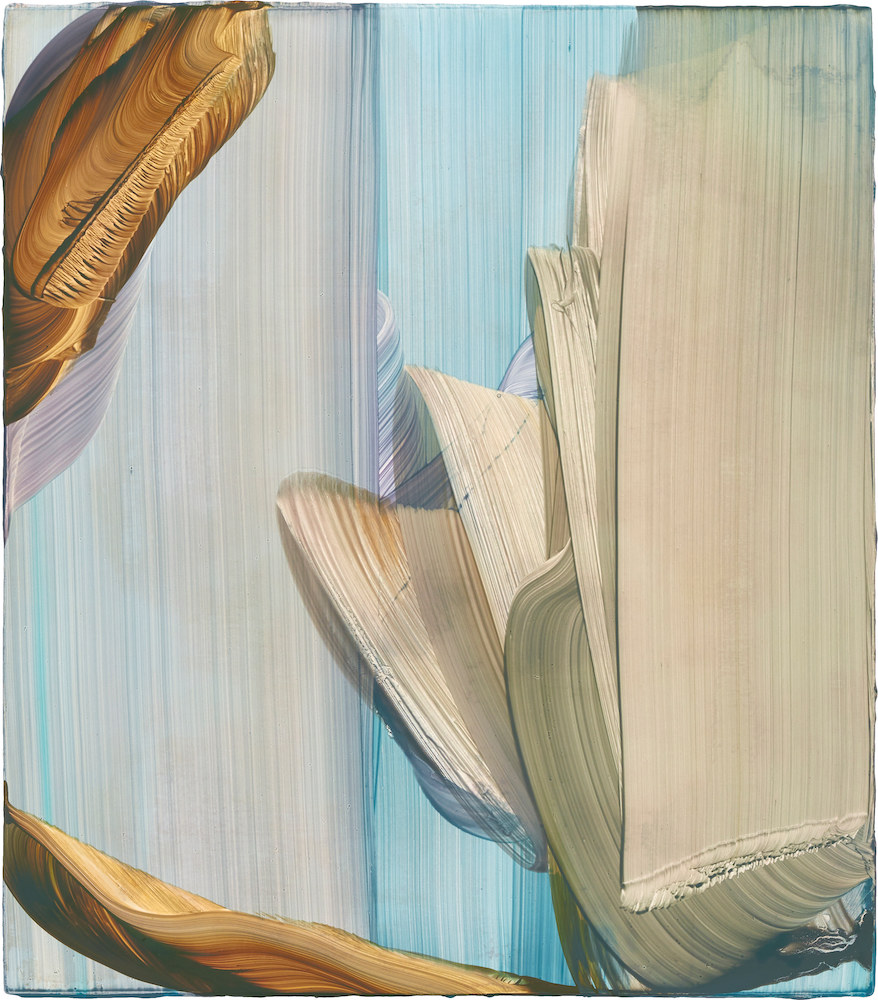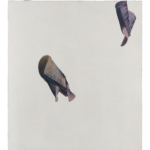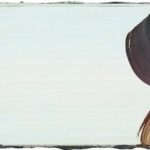Exhibition
in Zürich / Switzerland
- Markus Saile: untitled, 2022, signed & dated verso, oil on wood, 43 x 38 cm, 16 7/8 x 15 in
- Markus Saile: Ohne Titel, 2019, signed and dated verso, oil on wood, 13.5 x 16.5 x 1.5 cm, 5 1/4 x 6 1/2 x 5/8 in
- Markus Saile: untitled, 2022, signed & dated verso, oil on wood, 111 x 99 cm, 43 3/4 x 39 in
- Markus Saile: untitled, 2022, signed & dated verso, oil on wood, 11 x 47 cm, 4 3/8 x 18 1/2 in
Markus Saile’s new works convene the space of painting, in a subtle interplay between the space where it is situated, the space it represents and the space it constructs in dialogue with architecture. Beyond the in-situ and the context, it is an investigation into painting in volume, the depth of the surface, and the extension of this practice into a performative field of action. Several edges are at stake in the work of Markus Saile. The ones of the painting as an object: a wooden panel, the ones of the walls on which they are hung and in between which they stand, in dialogue with the architecture of the place, the ones of the experience of vision in motion inside and outside the surface. The space of the gallery is a venue but also a place of actions, setting our ways of looking according to our behaviors.
The paintings play with the edges of the wall in two modes at least, the “edge to edge” and the other which is going beyond the edge, and in a way “avoid the corner”. Here it is a matter of format, horizontality being attributed to landscape and a position of viewer looking at a fragment of nature, from an architectural space.
They offer a lateral vision that gives to the margin a structural position of support. Not only technical but symbolic: it is the margins that holds the work. And this is repeated in the very configuration of the installation in the Mai 36 Galerie. This is physically experienced by crossing the threshold. The way one painting is hanged inside the passage from room 1 to 2 expresses two ways of filling and feeling the border. Literally between two spaces but also from one wall to the next, which constitutes a gate. On the inside wall of the door, a grey painting (62 x 80 cm) stands literally between the two edges of the wall. But it plays also with its own border-lines which are seen first as a sliding movement. The patterns of the paintings play a push and pull effect which rebounds inside the surfaces. Large brush strokes with metallic appearance build a mesh of horizontal grey squares vibrating from deep grey to white, absorbed by the width of the internal wall. It abstracts the angle by repeating it.
Post-sublime, as there is no place for a unique point of view today but always one painting and the corner of another or the plane of the wall. Glimpse, glance, are set in a bridge relation created by the viewer’s pace. Never isolated but in movement, the works are a constellation of various surfaces. They act as a grammar of forms which agglutinates and separates according to an open meaning. Literally, the paintings perform the space.
The lighting attracts our eyes, coming from the gesso through the transparent layers of paint. They are like analogue screens in a sense: what we see is what we see, not a re-presentation but an ongoing diffraction of painting facts. This is a non-representational painting which is not abstract.
Then the in between space, in between the paintings, creates a political space where we stand and move, as viewers, and this would link to the post-performance painting. A painting which is a source or destination of a body action. Here the twist between the window metaphor of the painting as a means to see inside to outside but also from outside to inside is replaced by the wall to wall, slide to side effects. Also, a window is the square that you open in your computer when you want to see several things at the same time which is a way of layering a screen surface, too. Today, pictorial problems are architectural problems, in the sense of a socio-political structure.
Marie de Brugerolle
Gallery hours Tue – Fri 11 am – 6.30 pm, Sat 11 am – 5 pm
Opening Hours during Zurich Art Weekend
Friday, June 10, 11 – 8 pm
Saturday, June 11, 11 – 8 pm
Sunday, June 12, 11 – 6 pm
Exhibition Duration 10 June – 13 August 2022
Markus Sailes neue Arbeiten rufen den Raum der Malerei auf – als subtiles Zusammenspiel des Raumes, in dem sie situiert ist, mit dem Raum, den sie repräsentiert und dem Raum, den sie im Dialog mit der Architektur konstruiert. Über Ort und Kontext hinaus handelt es sich um eine Untersuchung der Malerei im Hinblick auf Volumen, Tiefe der Oberfläche und die Ausweitung dieser Praxis in ein performatives Handlungsfeld.
In seinem Werk sind mehrere Ränder im Spiel: die des Gemäldes als Objekt, einer Holztafel; die der Wände, an denen sie hängen und zwischen denen sie stehen, im Dialog mit der Architektur des Ortes; die der Erfahrung eines Sehens in Bewegung, innerhalb und außerhalb der Oberfläche. Der Galerienraum ist ein Austragungsort, aber auch ein Ort des Handelns, der unsere Sehgewohnheiten in Abhängigkeit von unserem Verhalten bestimmt.
Die Gemälde beziehen sich in mindestens zwei Modi auf die Ränder der Wand, im Modus “Rand zu Rand” (edge to edge) und in einem Modus, der über den Rand hinausgeht und in gewisser Weise “die Ecke vermeidet”. Es handelt sich dabei um eine Frage des Formats, wobei Horizontalität der Landschaft zugeschrieben wird, und der Position von Betrachter*innen, die von einem architektonischen Raum aus auf ein Fragment der Natur blicken.
Sie bieten eine seitliche Ansicht, die der Bildkante die strukturelle Position eines Trägers verleiht. Nicht nur technisch, sondern auch symbolisch sind es die Ränder, die das Werk tragen. Und dies wiederholt sich in der Konfiguration der Installation bei Mai 36. Physisch erfahrbar wird es, wenn man die Schwelle zum linken Ausstellungsraum überschreitet. Die Art und Weise, wie das Gemälde im Durchgang platziert ist, drückt zwei Arten aus, die Grenze zu füllen und zu spüren. Buchstäblich zwischen zwei Räumen, aber auch von einer Wand zur nächsten, wodurch eine Torsituation ensteht. Dort hängt zwischen den Türöffnungen ein graues Gemälde (62 x 80 cm) passgenau zwischen den beiden Kanten der Wand. Aber es ruft auch seine eigenen Grenzlinien auf, die zunächst als gleitende Bewegung wahrgenommen werden. Die Muster des Gemäldes spielen mit einem Push-and-Pull-Effekt, der im Inneren der Flächen abprallt. Große, metallisch anmutende Pinselstriche bilden ein Geflecht aus horizontalen grauen Rechtecken, die vom Dunkelgrau ins Weiße vibrieren und von der Breite der Innenwand absorbiert werden. Es abstrahiert den Winkel, indem es ihn wiederholt.
Postsublim, da es heute keinen Platz mehr für einen eindeutigen Standpunkt gibt, sondern immer ein Bild und die Ecke eines anderen oder die Wandfläche. Flüchtige, streifende Blicke – ein Brückenverhältnis, das durch die Schritte der Betrachter*innen hergestellt wird. Niemals isoliert, sondern in Bewegung, sind die Werke eine Konstellation verschiedener Oberflächen. Sie fungieren als eine Grammatik von Formen, die sich gemäß einer offenen Bedeutung zusammenballen und trennen. Die Gemälde führen den Raum buchstäblich auf.
Das Leuchten lockt unsere Augen, es dringt von der Grundierung aus durch die transparenten Farbschichten. Es funktioniert in gewisser Weise wie ein analoger Bildschirm: Wir sehen was wir sehen, keine Re-Präsentation, sondern eine fortlaufende Beugung (diffraction) der malerischen Tatsachen. Es handelt sich um eine ungegenständliche Malerei, die nicht abstrakt ist.
Der Zwischenraum zwischen den Gemälden schafft folglich einen politischen Raum, in dem wir als Betrachter stehen und uns bewegen – und dies wäre eine Verbindung zur post-performance-Malerei. Ein Gemälde, das eine Quelle oder ein Ziel körperlicher Aktion ist. Hier wird die Fenstermetapher des Gemäldes mit den wechselnden Blickachsen von innen nach außen und von außen nach innen ersetzt durch die Kräfte von Wand-zu-Wand und seitlichen Wischbewegungen. Ein Fenster ist auch das Rechteck, das man in seinem Computer öffnet, wenn man mehrere Dinge gleichzeitig sehen will und das ebenfalls eine Art der Schichtung der Bildschirmoberfläche darstellt. Heute sind bildnerische Probleme architektonische Probleme im Sinne einer sozio-politischen Struktur.
Marie de Brugerolle
Öffnungszeiten Di-Fr 11 – 18.30 Uhr, Sa 11 – 17 Uhr
Öffnungszeiten während des Zurich Art Weekend
Freitag, Juni 10, 11 – 20 Uhr
Samstag, Juni 11, 11 – 20 Uhr
Sonntag, Juni 12, 11 – 20 Uhr
Ausstellungsdauer 10.06. – 13.08.2022
Location:
Mai 36 Galerie
Rämistrassse 37
8001 Zürich
Switzerland





